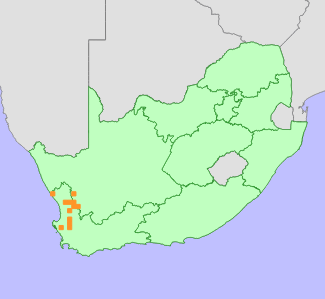|
Scientific Name | Oxalis disticha Jacq. |
Higher Classification | Dicotyledons |
Family | OXALIDACEAE |
National Status |
Status and Criteria | Near Threatened B2ab(iii,v) |
Assessment Date | 2016/08/04 |
Assessor(s) | L. von Staden |
Justification | A widespread (EOO 20 128 km²), but highly localized habitat specialist (AOO <50 km²). It is still fairly common in spite of widespread, ongoing habitat degradation, estimated to occur at between five and 10 locations, but is likely to continue to decline. |
Distribution |
Endemism | South African endemic |
Provincial distribution | Northern Cape, Western Cape |
Range | Bokkeveld Escarpment to Mamre. |
Habitat and Ecology |
Major system | Freshwater |
Major habitats | Agter-Sederberg Shrubland, Citrusdal Vygieveld, Vanrhynsdorp Gannabosveld, Swartland Shale Renosterveld, Nieuwoudtville Shale Renosterveld, Vanrhynsdorp Shale Renosterveld, Namaqualand Granite Renosterveld, Namaqualand Riviere, Fynbos Riparian Vegetation |
Description | Seasonal pools and pans on clay soils, rarely in sandy soils in streambeds. Plants are often floating in standing water. |
Threats |
| Areas surrounding this species habitat is extensively cultivated, however, seasonal pools are not generally ploughed, except in a few instances where pools have been filled in. The most severe causes of degradation of vernal pools in the Western Cape and on the Bokkeveld Escarpment is heavy overstocking with livestock, which leads to overgrazing and trampling of sensitive wetland systems, as well as eutrophication due to fertilizer runoff, which is aiding the spread of alien invasive grasses. Dense alien grass infestations are outcompeting native species in many wetland systems. None of this species' habitat is currently formally protected. |
Population |
This species occurs in isolated, scattered subpopulations confined to suitable habitat. It is however locally abundant, and subpopulations are large. It is currently known from nine existing subpopulations, and many recent records indicate that it is still fairly common in spite of extensive habitat loss and degradation.
|
Population trend | Decreasing |
Assessment History |
Taxon assessed |
Status and Criteria |
Citation/Red List version | | Oxalis disticha Jacq. | NT B2ab(iii,v) | 2017.1 | | Oxalis disticha Jacq. | Least Concern | Raimondo et al. (2009) | |
Bibliography |
Cook, C.D.K. 2004. Aquatic and wetland plants of southern Africa. Backhuys Publishers, Leiden, The Netherlands.
Goldblatt, P. and Manning, J.C. 2000. Cape Plants: A conspectus of the Cape Flora of South Africa. Strelitzia 9. National Botanical Institute, Cape Town.
Manning, J.C. and Goldblatt, P. 2012. Plants of the Greater Cape Floristic Region 1: The Core Cape Flora. Strelitzia 29. South African National Biodiversity Institute, Pretoria.
Raimondo, D., von Staden, L., Foden, W., Victor, J.E., Helme, N.A., Turner, R.C., Kamundi, D.A. and Manyama, P.A. 2009. Red List of South African Plants. Strelitzia 25. South African National Biodiversity Institute, Pretoria.
Salter, T.M. 1944. The genus Oxalis in South Africa: a taxonomic revision. Journal of South African Botany Supplement 1:1-355.
Sieben, E.J.J. 2009. The status and distribution of vascular plants (Magnoliophyta, Lycophyta, Pteridophyta). In: W.R.T. Darwall, K.G. Smith, D. Tweddle and P. Skelton (eds.), The status and distribution of freshwater biodiversity in southern Africa (pp. 83-98), IUCN and SAIAB, Gland, Switzerland and Grahamstown, South Africa.
|
Citation |
| von Staden, L. 2016. Oxalis disticha Jacq. National Assessment: Red List of South African Plants version 2024.1. Accessed on 2025/11/17 |
 Comment on this assessment
Comment on this assessment


